Protea cynaroides
| Botanical Name | Protea cynaroides |
|||||||||||||||||||||
| Family | Proteaceae - The Protea family
|
|||||||||||||||||||||
| Pronunciation | PROH-tee-uh sin-nar-OY-deez |
|||||||||||||||||||||
| Common Name(s) |
English: King Protea
Afrikaans: Grootsuikerkan
IsiXhosa: isiqwane; esincinci
|
|||||||||||||||||||||
| Plant Group |
|
|||||||||||||||||||||
| Plant Size |
|
|||||||||||||||||||||
| Position |
|
|||||||||||||||||||||
| General Information |
|
|||||||||||||||||||||
| Specific Information | The King protea is known worldwide as a magnificent cut flower and is South Africa's national flower. Usually about 1 meter tall, it varies remarkably depending on habitat and climatic conditions, resulting in a large variety of leaf- and flower sizes, height from 35 cm to 2 meters, as well as variations in colour and flowering times. Protea cynaroides is a woody shrub with large dark green, glossy leaves. The thick stems grow from an underground rootstock. As with most proteas it grows in soils with very low amounts of nutrients. Protea cynaroides is adapted to survive fires by its thick underground stem, which contains many dormant buds, ready to produce new growth after the fire. Protea cynaroides grows in harsh environments with dry, hot summers and wet, cold winters. The tough, leathery leaves prevent excessive loss of moisture, and a large taproot penetrates deep into the soil to reach underground moisture. Like most other Proteaceae, the King protea has 'proteoid' roots, roots with dense clusters of short lateral rootlets that form a mat in the soil just below the leaf litter. It is with these roots that the protea derives its nourishment. Large, vigorous plants produce six to ten flower heads in one season although some plants have many more than this. Not well suited to very dry areas, regions with very severe frost or to hot humid conditions. |
|||||||||||||||||||||
| Ad Break | ||||||||||||||||||||||
| Flowers | ||||||||||||||||||||||
| Description | Large heads from 120 mm to 300 mm in diameter, consisting of a collection of flowers in the center, surrounded by large colourful bracts. |
|||||||||||||||||||||
| Season |
|
|||||||||||||||||||||
| Colour |
|
|||||||||||||||||||||
| Growth Rate |
|
|||||||||||||||||||||
| Plant Uses |
|
|||||||||||||||||||||
| Distribution and Habitat | from the Cedarberg Mountains in the northwest of the Western Cape Province to Grahamstown in the Eastern Cape Province, from sea level to 1 500 meters high, growing in fynbos and on medium to high rainfall mountain slopes |
|||||||||||||||||||||
| Planting Suggestions | The King protea demands very well-drained, nutrient poor soil in a sunny, airy position. They will not grow well in clay soils and will die if their roots are kept wet. If possible plant on a slope or on slightly elevated mound to prevent drainage problems. In the cooler summer rainfall regions try for a north facing slope. Dig a hole twice the width of the container and one and a half times the height. Do not apply artificial fertilizer or fresh manure to the soil mix. Mulch well around the plant but keep the area around the trunk of the plant clear, as the crown of the plant must be able to dry off. Proteas have a dense network of fine roots just below the surface of the soil and no cultivation should take place below them as disturbance will damage the roots and possibly introduce fungal disease, resulting in the death of the plant. The use of a thick mulch of leaf litter and pine bark/needles will feed the plant, keep the soil cool and discourage weeds. In summer rainfall areas water regularly during winter and occasionally in summer if the weather is dry. A plant that is not thriving may be over-watered, poorly drained or be planted in too rich a soil. |
|||||||||||||||||||||
| Medicinal Uses | No data found. |
|||||||||||||||||||||
| Ad Break | ||||||||||||||||||||||


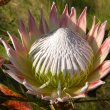
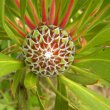


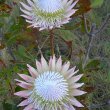
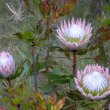
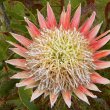
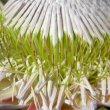
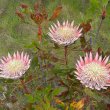
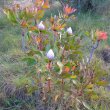



Comments
King protea
I potted a king protea, which had 5 flower buds and I have lost all the flowers and was wondering what cases that to happen. I water just before the plant dries and would say I water 2 or 3 times per week. The plant is in full sun. The soil I used was recommended by a nursery and I have not used any fertilisers
King Protea transplant
Hi Norman
My feeling is that if the plant already had flower buds, it was a bit too old to be transplanted. Did you transplant from a bag you bought from a nursery or a plant from the ground? I have discovered over the years that almost any plant that is transplanted while in flower is bound to lose its flowers. Added to that is the fact that Proteas are soooo touchy about having their roots disturbed - in fact I am surprised that your plant has survived at all.
I think too that you may be over-watering. Proteas do not like having their roots wet. I would suggest you water only when the soil is completely dry, then water well and wait again until the soil is dry. The proteas in my garden often go for months without water and we have long droughts lasting more than 5 years at a time. The proteas manage to flower successfully every year.
Hope this helps and that your protea goes on to thrive.
Kind regards
Lorraine
King protea losing budet flowers
Thanks Lorraine for the tips. I transplated from a bag and the plant at that stage had buded flowers although I have lost all the new buds I have a lot of new growth and the King protea really looks heathy.
Protea in a pot
Happy to hear this. Please send me a picture through my email (kumbulanursery@gmail.com) so I can include it with my photos. I've had a few queries about keeping proteas in containers, especially from overseas. It would be nice to have a visual.
Regards
Lorraine
Protea Cyranoides
I have protea cyranoides plants that had nice new growth. I have noticed that on some of the plants the new growth has turned brown or bronze in colour and are dying. It hasn't affected the older leaves. I have spent hours looking for reasons for this.Had lots of rain after a long dry summer, but they have been well watered through this. No frosts and only a tiny amount of Ammonia sulphate. Any Ideas?
Protea cynaroides
Hi Nigel
My apologies for being so tardy in replying to your query, but I have given it a great deal of thought. Here is what I think may have happened.
When proteas are in stress, the damage becomes visible from the new growth and travels downwards towards the older growth so would only affect the lower parts of the plant later. This kind of die-off invariable means that the roots have been compromised in some way.
Proteas do not need much moisture during summer as they come from a Mediterranean climate where there is very little precipitation during the summer months. By the time the winter rains arrive, the soil deep down is pretty dry.
The heavy rain you mention is thus a concern. Is it possible that the water did not drain away quickly enough? Having been watered well during summer, it is possible that the soil deeper down was already wet and the water was unable to drain away fast enough. This would result in a fungal disease causing the roots to rot. This happens very easily with protea roots as they are super sensitive to too much water. You would not necessarily see the water above ground - this would have happened much deeper down. The fact that not all the plants were affected would be related to the varying drainage properties of the soil below the surface.
If the roots have contracted a fungal disease, the look-out is very poor. By the time any damage is noticed, it is usually too late to do anything about it and the plants die - usually very quickly.
I sincerely hope that this is not the case with your plants. Do please let me know how they progress and whether any or all of them survive. It would certainly help me to gauge if my diagnosis is correct or not.
Kind regards
Lorraine
White cynaroides protea.
Hi, I am looking for a white/ cream cynaroides protea.
I live in KZN.
Would you know of anyone who sells them?
Regards
Poppet Mockford.
Protea cynaroides - white
Hi Poppet
Unfortunately I can't help you. The only growers that I know of that stock this rare protea are in Australia, the UK and the USA. There is one farm in South Africa that has started growing the white cynaroides but this is only for the export flower market.
Kind regards
Lorraine
White king protea
Hi, not sure if you are still looking but I have just ordered 2 white King protea from Dieters Nursery in Hillcrest. Their full range of protea will be in by the end of August 2015. Try and give them a call and pre-order.
White Protea cynaroides for sale
Hi Karin
Many thanks for letting us know.
For photos of the nursery and contact details, go to
http://livinghillcrest.blogspot.com/2013/05/loving-dieters-nursery.html
Kind regards
Lorraine
white King Proteas
Hi,
Dieters sell at around R200 a pop. They purchase them from Arnelia, who will sell them to you at about R100 a pop, delivered ex their nursery in the Cape. As a note, Arnelia have to pay royalties on each bush to a third party - who controls the whole White King market in the country. Google Arnelia for for more info.
Pruning the King Protea
Hi,
I planted a young king protea in a large wine barrel type pot at the beginning of this year. It has grown along shoot(over a meter) plus another shorter one to the side. There are no other shoots and it is not really forming a bush.
Can I prune the plant as I want it to grow more as a bush.
Thanks
André
Pruning proteas
Hi Andre
I am referring you to an excellent site that will give you the information you need. Go to: http://finebushpeople.com/content/how-prune-protea-bushes.
Kind regards
Lorraine
Protea cynaroides "Mini King" "Little Prince"
I live in San Francisco California and would like to know a source (retail, wholesale or grower) in the USA (preferably in the western USA)to obtain this plant. Thanks
Jason
Protea growers in western USA
Hi Jason
I'd love to help but statistically it is impossible for me to keep world-wide records of nurseries and their stock lists. Hopefully a reader will be able to help out.
Kind regards
Lorraine
Disease's on Proteas
My King Protea leaves started to get orange blotches on them which eventually made the whole leaf brown before falling off. Thinking it was a fungal disease I sprayed the plant with a fungicide containing copper which did not help. I then cut back all the diseased and leafless branches to promote new growth. The plant responded very well and new shoots were sprouting all over the bush but this was short lived and within a month the plant had died. What is the cause of these blotches on the leaves and how can I treat them as it also occurs on other proteas ie Red Ice, repens and pin cushions?
White King Protea Plants
Hi There
Where can i contact Amelia so that i can purchase 3000 white king protea plants
Regards
Replanting protea
Hi
I have a King Protea about 3 years old, standing tall about 1.5m and need to move it to another corner of my property urgently. It is now "sunny" winter in the Cape, what is your suggestion to make sure I don't lose the plant when moving it to the new spot.
Thanks
Moving proteas
Hi Anelma
Even digging near or around a Protea will be enough to kill it. I have never transplanted a Protea bigger than 10 cm tall so I am unable to make any suggestions.
Kind regards
Lorraine
Protea
I live SF Bay area, CA. In June/July we planted a Protea (not sure which one)in an area that has full sun. We thought it was doing good. But now that we have had rain and temp. changes back and forth between hot and cold. We saw today that the center of the plant has alot of brown leaves. We are not sure what to do for it. I have read alot of opinions, I don't want to lose it. Can you help us? Thank you so much.
Ailing Protea
Hi AJ
I can't really make any diagnosis with so little information. Can you send a few pictures?
Regards
Lorraine
Discuss this plant
Share knowledge, ask a question or give an experience.